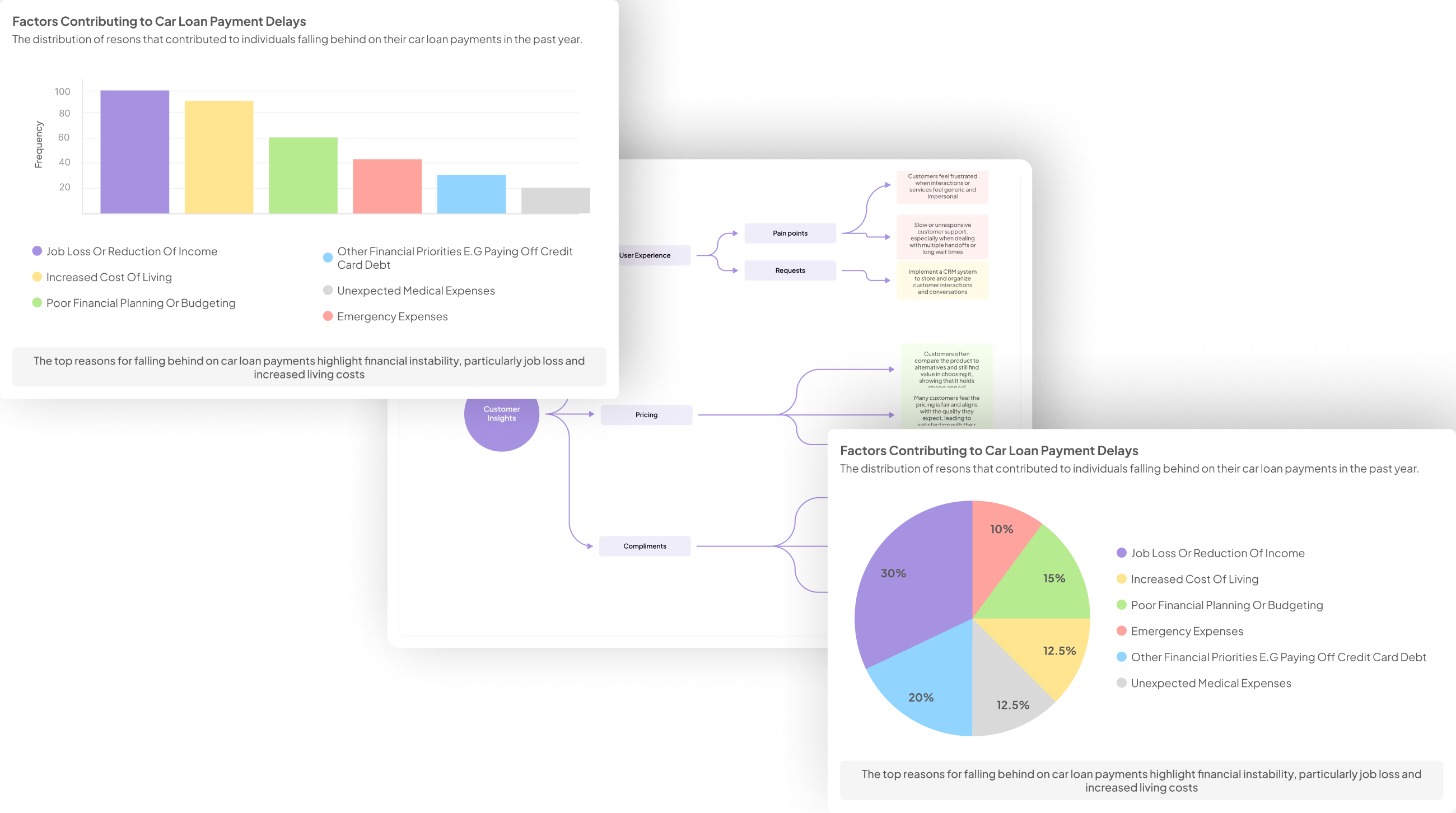How to Analyze Prospect Interviews
-
Bella Williams
- 10 min read
Interview Analysis Techniques begin at the heart of understanding your customer's voice. Engaging in prospect interviews provides a wealth of information that can drive strategic decisions, yet it's easy to overlook potential insights hidden within those conversations. Effectively analyzing these interviews is vital for businesses that wish to stay ahead in a competitive market.
This section will explore various methods that can enhance your ability to extract valuable information from your interviews. By implementing specific techniques, you can identify crucial patterns and insights, ultimately leading to more informed business actions. Understanding these techniques will empower you to transform raw data into actionable strategies, ensuring you fully leverage the knowledge gained from each interaction.
Generate visualizations from your qualitative data. At Scale.

Understanding the Basics of Interview Analysis Techniques
Interview analysis techniques are essential for transforming raw data from prospect interviews into actionable insights. Understanding these techniques begins with recognizing the importance of listening carefully and asking the right questions. These conversations serve as a goldmine of information, but only if the insights are effectively analyzed.
Start by establishing a clear framework for your analysis. This involves organizing the data, identifying common themes, and pinpointing critical insights that align with your objectives. Techniques like thematic analysis or coding can help streamline this process. As you delve deeper, be on the lookout for patterns and anomalies that might inform product development or service enhancements. By mastering these basics, you can enhance the overall quality of your interviews and turn customer feedback into a powerful tool for growth.
Why Interview Analysis Techniques Matter
Interview analysis techniques play a crucial role in transforming raw customer conversations into meaningful insights. Understanding the nuances behind these techniques enables us to make better business decisions, ultimately leading to improved strategies and outcomes. The ability to analyze interviews effectively allows teams to pinpoint customer needs and expectations, which are essential for growth and innovation.
When applied correctly, interview analysis techniques streamline the process of extracting valuable information from discussions. This significantly reduces the time taken to deliver insights and enhances collaboration across departments. Companies that prioritize these techniques can respond faster to market demands and maintain a competitive edge. Insights derived from thorough analysis also help in crafting tailored solutions, thus fostering stronger customer relationships. By honing these skills, businesses not only optimize their operations but also empower their teams to make informed, strategic decisions.
Tools and Methods for Effective Analysis
Analyzing prospect interviews can be a complex task, but employing effective tools and methods can greatly enhance your outcomes. To streamline this process, it's essential to utilize a combination of qualitative and quantitative analysis techniques. Start by organizing your data into categories that reflect themes identified during the interviews. This can aid in spotting key insights and patterns that emerge, allowing for a more structured analysis.
Visual tools, such as charts and graphs, can also be beneficial in illustrating trends or sentiments expressed by interviewees. Additionally, consider using transcription software to convert spoken data into text format, making it easier to highlight significant quotes or feedback. Implementing these methods not only boosts the effectiveness of your analysis but also helps in drawing actionable conclusions from the insights gathered during the interviews.
Evaluate Performance on Customer Calls for Quality Assurance.
Steps to Mastering Interview Analysis Techniques
Mastering interview analysis techniques involves systematic steps that can enhance your understanding of prospect interviews. First, it's essential to establish a robust framework that guides your analysis. This framework should focus on specific goals, questions, and the context of your interviews, allowing you to direct your attention to relevant aspects that matter.
Next, identifying key patterns and insights becomes crucial. After collating your interview data, look for recurring themes, notable quotes, and significant data points that reveal customer sentiments. By synthesizing these insights, you can form actionable strategies that help address customer needs efficiently. As you practice these steps, your ability to analyze interviews will improve, leading to deeper insights and more effective decision-making in your business. With diligence and a clear approach, mastering these techniques will position you ahead of your competitors.
Step 1: Preparing Your Framework
Preparing your framework is a crucial initial step in analyzing prospect interviews effectively. By establishing a well-defined structure, you ensure that your analysis remains focused and methodical. Begin by defining your objectives; understand what you want to achieve from the interviews. Are you looking for common customer pain points, or are you more interested in the effectiveness of your messaging? Clarifying your goals will guide your analytical approach.
Next, choose the right interview analysis techniques. This may include organizing interviews by themes or tagging responses for detailed insight extraction. Additionally, consider developing a framework that incorporates key performance indicators to measure success. This combination not only streamlines your analysis but also enhances your ability to draw actionable insights from the interviews. Having a robust framework in place lays the foundation for deeper analysis and ultimately drives better decision-making processes.
Step 2: Identifying Key Patterns and Insights
To successfully identify key patterns and insights from interviews, a structured approach is essential. Begin by organizing your interview data into manageable projects. This step allows you to focus on specific timeframes or topics, enabling a clearer analysis. When you compile the transcripts, identify recurring themes and trends across multiple conversations. Utilize tools that can aggregate data to reveal overall patterns, such as pain points or frequently mentioned topics.
Next, analyze these insights quantitatively and qualitatively. For instance, count how many participants mention a specific issue. This figure provides a numerical context to the qualitative feedback. Capturing the essence of the dialogue through summaries can also reveal what resonates most with the audience. By implementing these steps, you transform raw interview data into actionable insights that inform decision-making and strategy formulation. Effective identification of these patterns is a crucial skill in refining your interview analysis techniques.
Conclusion: Refining Your Interview Analysis Techniques
To refine your interview analysis techniques, embrace a systematic approach that enhances your understanding of the gathered data. Begin by organizing your transcripts and insights into manageable projects, which can reveal trends and patterns over time. Reviewing interviews collectively allows for a comprehensive analysis of feedback, highlighting customer pain points and needs.
Once you identify these core themes, leverage them to develop actionable insights that inform your strategy. Utilize reporting tools to visualize the data, making it easier to share findings with your team. By continually refining your interview analysis techniques, you will improve your ability to derive meaningful insights, driving better decisions and fostering deeper connections with your prospects.







